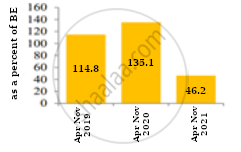Advertisements
Advertisements
प्रश्न
Compare the trends depicted in the figures given below:
| Figure 1: Trends in Fiscal deficit and Primary deficit |
Figure 2: Fiscal deficit as a percent of Budget estimate |
 |
 |
उत्तर
Considering the data represented in the given diagram, trend of year-on-year deficit (reporting for April to November) may be stated as follows:
- Fiscal Deficit in 2020 increased to 10.8 lakh crore from 8.1 lakh crore in 2019. In 2021 it has gone down to 7 lakh crore.
- Primary Deficit in 2020 increased to 6.9 lakh crore from 4.7 lakh crore in 2019. In 2021 it has gone down to 2.4 lakh crore.
- Fiscal Deficit in 2020 increased to 135.1% of Budget Expenditure from 114.8% in 2019. In year 2021, it is 46.2% of Budget Expenditure.
APPEARS IN
संबंधित प्रश्न
Fiscal deficit equals :
(a) Interest payments
(b) Borrowings
(c) Interest payments less borrowing
(d) Borrowing less interest payments
Explain 'Revenue Deficit in a Government budget? What does it indicate?
Define revenue
Give the relationship between the revenue deficit and the fiscal deficit.
We suppose that C = 70 + 0.70Y D, I = 90, G = 100, T = 0.10Y (a) Find the equilibrium income. (b) What are tax revenues at equilibrium Income? Does the government have a balanced budget?
Explain why the tax multiplier is smaller in absolute value than the government expenditure multiplier.
Discuss the issue of deficit reduction.
Fiscal deficit = ______.
A fiscal deficit is equal to borrowings. It is ______
When the revenue receipts are less than the revenue expenditures in a government budget, this shortfall is termed as
How do we get the primary deficit from the fiscal deficit?
Which of the following statements is true?
Primary deficit is borrowing requirements of government for making:
Fiscal Deficit equals:
The shape of average revenue curve in monopoly is ______
How good is the system of G.S.T as compared to the old tax system?
On the basis of the given information, calculate the value of:
- Fiscal deficit
- Primary deficit
| S.No. | Items | 2021-22 (₹ in crore) |
| (i) | Revenue Receipts | 20 |
| (ii) | Capital Expenditure | 15 |
| (iii) | Revenue Deficit | 10 |
| (iv) | Non-debt creating capital receipts | 50% of revenue receipts |
| (v) | Interest Payments | 4 |
A large amount of fiscal deficit proves to be counter productive. Give any two reasons in support of this statement.
